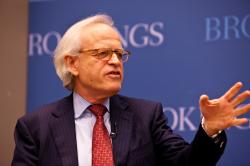

12:30 pm EDT - 2:00 pm EDT
Past Event
12:30 pm - 2:00 pm EDT
1775 Massachusetts Ave., NW
Washington, DC
On 20 April, 2006, the Saban Center for Middle East Policy at the Brookings Institution hosted Dr. Magnus Ranstorp, Research Director at the Swedish National Defence College, to discuss the dilemmas of U.S. policy toward armed Islamist groups in power. The policy luncheon was chaired by Saban Center Director, Martin S. Indyk.
Ranstorp, an internationally recognized terrorism expert, began his talk with a number of general reflections on Hamas in the Palestinian territories and Hizballah in Lebanon. In his view, the chief lesson that should be drawn with regard to armed Islamist groups is that these groups’ conceptions of time and space fundamentally differs from those of secular political actors. Hamas leaders, Ranstorp maintains, see no reason to hurry the creation of an “Islamic State of Palestine”, a vision which Hamas feels could be fulfilled sometime in the next two decades. The logic of this position arguably eliminates the possibility of Hamas reaching a negotiated peace with Israel, and brings into stark relief the strategic goals of the movement, namely an Islamic state stretching from the Jordan River to the Mediterranean Sea. The consensus nature of Islamist movements, Ranstorp believes, is a reality which demonstrates that any outward signs of moderation are offered merely to mask these groups’ long term strategic goals.
According to Ranstorp, it is important to bear in mind that Hamas and Hizballah have established a deep-rooted strategic partnership which makes divorcing one from the other not practically viable. Ranstorp attributed Israel’s deportation of over four hundred Hamas activists in the past to southern Lebanon, and their subsequent re-entry into the Palestinian territories, as the source of a relationship between Hamas and Hizballah that has become an important aspect of Hizballah’s deterrence posture vis-à-vis Israel.
While acknowledging the problematic nature of a virtual Hamas/Hizballah partnership for U.S. policy makers, Ranstorp was also quick to point out that Hizballah’s decision to participate in Lebanese parliamentary politics in 1992 may shed some light on Hamas’ potential course of action. Ranstorp argued that the way in which Hizballah has been articulating its demands—in areas such as electoral law reform, return of Lebanese prisoners held in Israeli jails, internal security reform, and the “Right of Return” for Palestinian refugees—provides a clue as to how the newly installed Palestinian leadership will raise similar issues. According to Ranstorp, “both groups rely on confrontation to get some traction” and both act in line with “a rational actor model and within red lines.”
On U.S. policy toward Hamas and Hizballah, Ranstorp was highly critical of what he sees as “a lack of imagination” by the United States in particular and of the West in general. He argued that Western policy makers should keep in mind that while Islamist movements may rely on confrontation with the West, they remain rational actors who are striving for legitimacy. Such legitimacy, he maintains, while an asset at present, could conceivably become a weakness in the future.
In Ranstorp’s assessment, the clearest area in which the West could seek to undermine the legitimacy of these movements, specifically Hamas, is through the economic, and the subsequent political, empowerment of women. Ranstorp talked about some of the potential consequences of Hamas’ electoral victory, namely a more traditional role for women in Palestinian society, the possible implementation of Islamic law, and the potential clash between Islamic and democratic values in Palestinian society. The West, he recommended, could pursue a policy that seeks to better the economic condition of Palestinians, particularly women, using tools such as micro-lending and the cultivation of transparent business practices.
Ranstorp also laid out some potential prescriptions for addressing Hizballah’s armed status, the first of which was the adoption of a policy of “carrots and sticks” towards the Lebanese Shi’ah group’s two external sponsors, Iran and Syria. He saw potential “carrots” in the offering of financial assistance, and a territorial compromise on the still disputed Sheba’a Farms. Possible “sticks” would include the threat of regime change and the imposition of international sanctions. Ranstorp was less than sanguine about the potential success of this strategy.
The second prescription for U.S. policy that Ranstorp proposed was a unilateral military solution to Hizballah’s weapons. Such a course of action would involve the deployment of U.S. Special Forces in Lebanon with a mandate of militarily engaging with Hizballah. However, Ranstorp believed that such strategy would entail tremendous costs and would ultimately have very little chance of achieving its desired goals.
Finally, Ranstorp suggested that the United States could ratchet up the pressure on the Lebanese government to find a solution to Hizballah’s arms through the use of diplomatic tools such as cutting off economic assistance, placing the country on the list of state-terrorism sponsors and persuading the European Union to take similar measures.
More generally, Ranstorp urged U.S. policymakers to keep in mind that Hizballah remains a rational actor that clearly understands and appreciates the rules of deterrence. He also advised that should the United States seek to impose a price upon Hizballah for actions the group has purportedly taken in the past, it would be more efficient for Washington to reveal these allegations in a transparent manner. Hizballah, Ranstorp believes, is likely to be amenable at least to some U.S. demands.
In the question and answer session, Ranstorp offered thoughts on the consequences of a potential collapse of the Hamas-led Palestinian Authority and U.S. and EU policies, the growing regional tension between Sunni and Shi’ah Muslims seen through the prism of the Hamas/Hizbollah relationship, the future of terrorism in the Palestinian territories and that of the young guard of Fatah, the previously dominant Palestinian nationalist movement, and finally the creation of mutual trust to build a working relationship between the United States and Islamist movements.
Read the full transcript (PDF140kb)


Vanda Felbab-Brown
April 11, 2024

Vanda Felbab-Brown
March 28, 2024

Suzanne Maloney
March 1, 2024